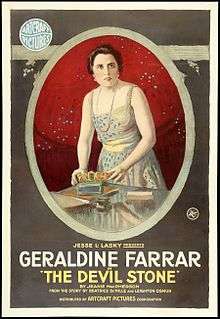The Devil-Stone
| The Devil-Stone | |
|---|---|
 Lobby poster | |
| Directed by | Cecil B. DeMille |
| Produced by |
Jesse L. Lasky Cecil B. DeMille |
| Written by |
Beatrice DeMille Jeanie MacPherson Leighton Osmun |
| Starring |
Geraldine Farrar Wallace Reid Hobart Bosworth Tully Marshall |
| Cinematography | Alvin Wyckoff |
| Edited by | Cecil B. DeMille |
Production company |
Famous Players-Lasky/Artcraft |
| Distributed by | Paramount Pictures |
Release date |
|
Running time | 60 minutes |
| Country | United States |
| Language | Silent (English intertitles) |

The Devil-Stone is a 1917 American silent romance film directed by Cecil B. DeMille and co-written by his mother Beatrice and his sometime lover Jeanie MacPherson and starring Geraldine Farrar. The film had sequences filmed in the Handschiegl Color Process (billed as the "DeMille-Wyckoff Process").
Only two of six reels are known to survive, in the American Film Institute Collection at the Library of Congress.[1][2]
This was the last of Farrar's films for Paramount Pictures.
Plot
As described in a film magazine,[3] Silas Martin (Marshall), a miser, marries Marcia Manot (Farrar) in order to gain possession of a valuable emerald she owns that once belonged to a Norse queen and is now cursed. After the wedding Marcia learns the true side of her husband and realizes that the marriage was a mistake. Silas steals the stone and places Marcia and Guy Sterling (Reid), his business partner, in a false light in order to get a divorce. Marcia sneaks in one night and discovers that Silas has the stone. She gains possession of it, but Silas attempts to regain it. They struggle, and Marcia kills him in self-defense. Sterling is accused of the murder, but the evidence clears him and the crime remains a mystery. Sterling marries Marcia and has an expert criminologist investigate the murder. He traces the crime to Marcia and, when confronted, she confesses. He gives her one month's leave of absence, after which she is to turn herself into the law. Marcia returns to her old home and gives the priest the emerald so he can make provision for homeless orphans. She returns and gives herself up to the criminologist. However, finding that her good deed has redeemed her, the criminologist does not turn her over to the law, and she and Sterling are happily reunited.
Cast
- Geraldine Farrar as Marcia Manot
- Wallace Reid as Guy Sterling
- Hobart Bosworth as Robert Judson
- Tully Marshall as Silas Martin
- James Neill as Simpson
- Mabel Van Buren
- Lillian Leighton
- Gustav von Seyffertitz as Stephen Densmore
- Horace B. Carpenter
- Ernest Joy
- Burwell Hamrick
- Raymond Hatton
- Theodore Roberts
See also
References
- ↑ Birchard, Richard S. (2009). Cecil B. DeMille's Hollywood. University Press of Kentucky. p. 28. ISBN 0813138299. Retrieved February 25, 2013.
Unfortunately, only two reels of the original six reels of The Devil-Stone are known to survive in the American Film Institute Collection in the Library of Congress.
- ↑ "The Devil-Stone". WorldCat. Retrieved February 25, 2013.
- ↑ "Reviews: The Devil-Stone". Exhibitors Herald. New York City: Exhibitors Herald Company. 6 (1): 26. December 29, 1917.
External links
- The Devil-Stone on IMDb
- Progressive Silent Film List: The Devil-Stone at silentera.com